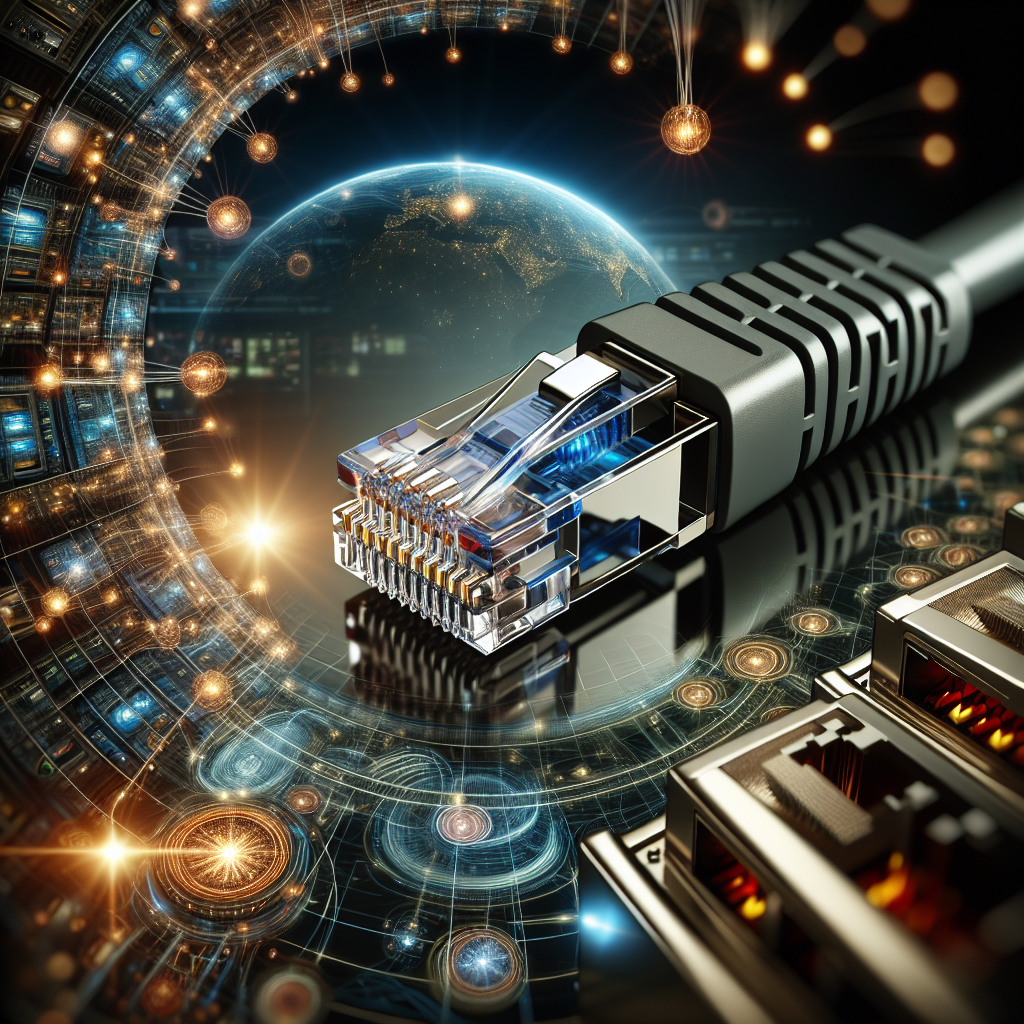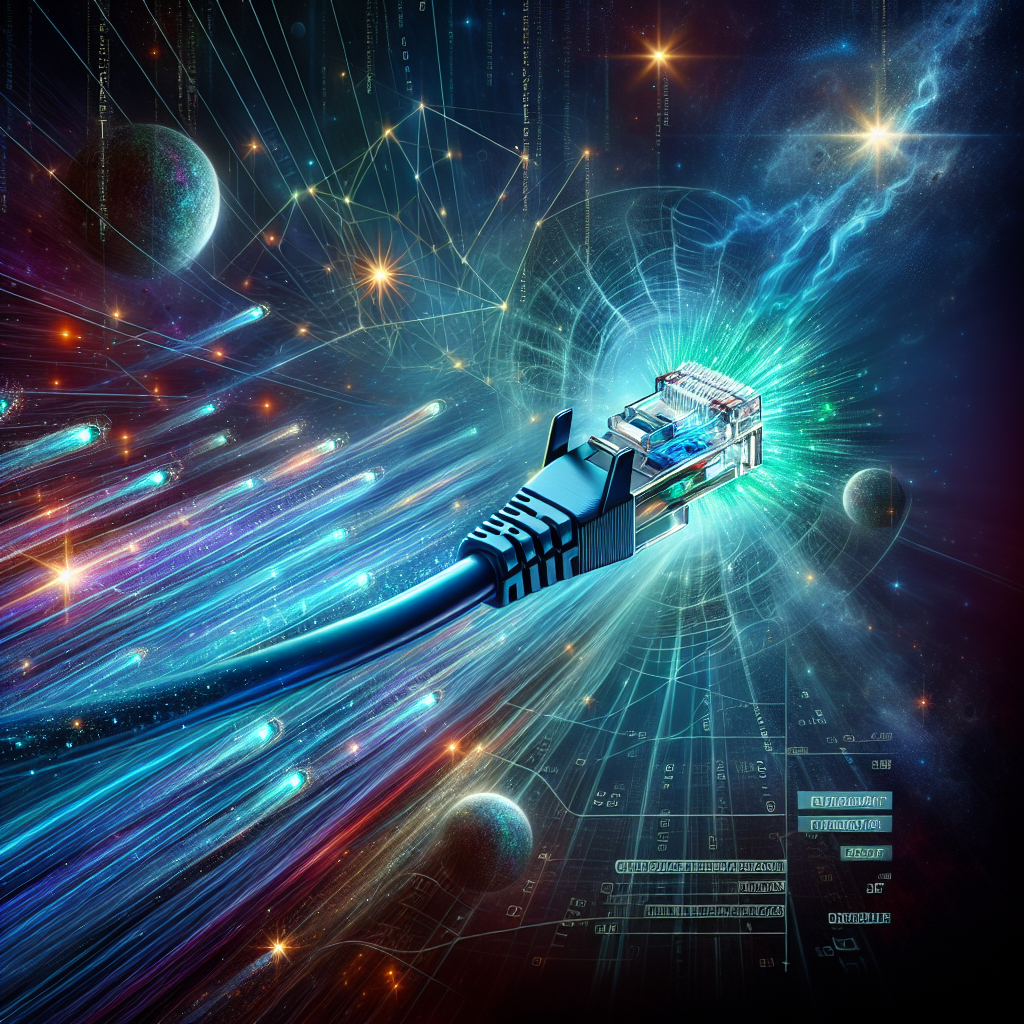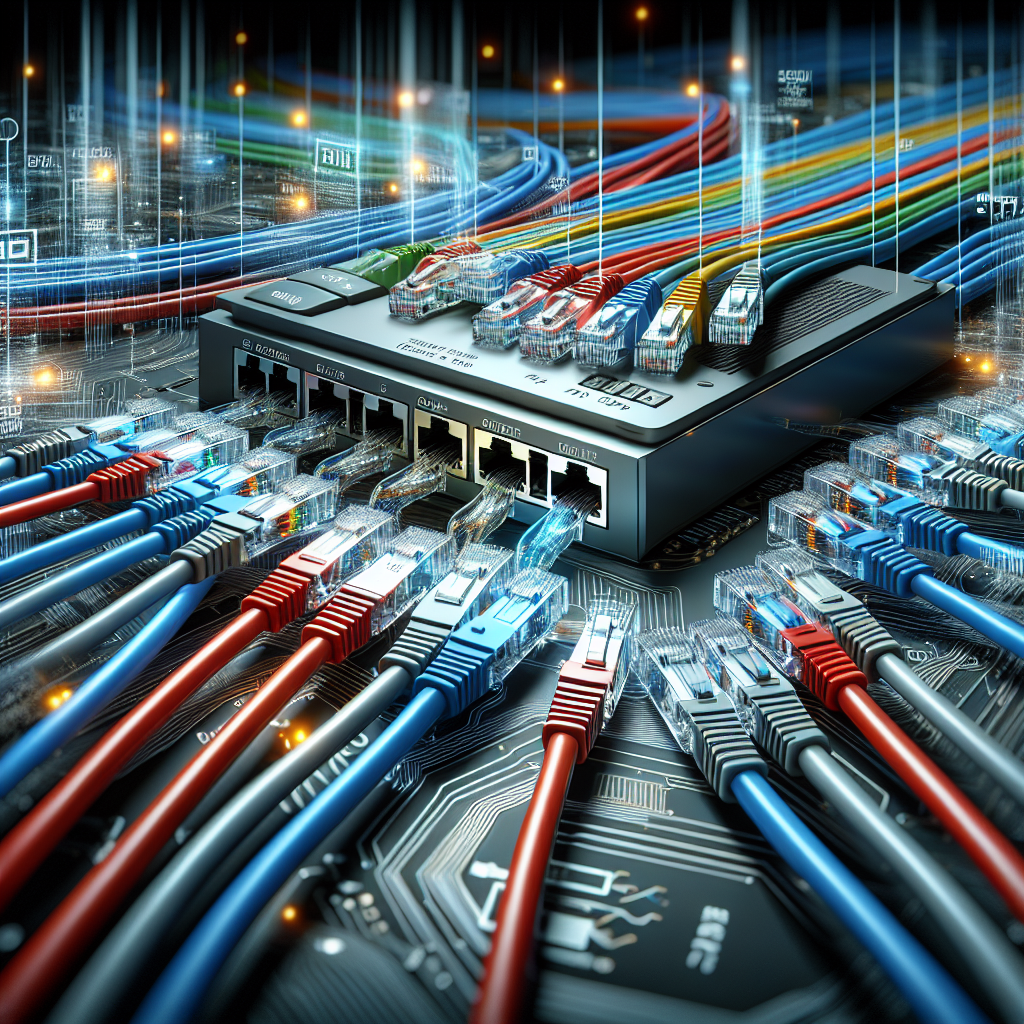In the digital age, a fast and reliable Ethernet connection is essential for smooth operation in our ever-connected world. From streaming movies to online gaming and virtual meetings, a stable connection is the backbone of modern technology. In this comprehensive guide, we will dive deep into the world of Ethernet connections, exploring the various types available and how to ensure your connection is fast and reliable. Discover the key components of a strong Ethernet setup, tips for troubleshooting common issues, and ways to optimize your connection for peak performance. Join us on this journey as we uncover the secrets to a seamless online experience.
Understanding the Basics of Ethernet Connection
Ethernet, in the realm of networking, refers to a widely used technology that enables devices to communicate with each other over a local area network (LAN). It operates on the principles of data link layer protocol in the OSI model, providing a framework for organizing and transmitting data packets between connected devices.
Definition of Ethernet
Ethernet is characterized by its standardized physical and data link layer specifications, which define aspects such as cable types, data transfer rates, and network topologies. It typically utilizes copper wires or fiber optics to establish wired connections between devices, ensuring reliable data transmission.
Evolution of Ethernet Technology
Since its inception in the 1970s, Ethernet has undergone significant evolution to meet the escalating demands of modern networking environments. From the initial 10 Mbps Ethernet standard, subsequent iterations such as Fast Ethernet (100 Mbps), Gigabit Ethernet (1 Gbps), and 10-Gigabit Ethernet have emerged to cater to the need for faster data speeds.
Importance of Fast and Reliable Ethernet Connection in Today’s Digital World
In today’s digitally-driven landscape, where data-intensive applications and services abound, the need for a fast and reliable Ethernet connection cannot be overstated. Businesses rely on Ethernet for seamless communication, efficient data transfer, and reliable network connectivity to support mission-critical operations. Embracing advancements in Ethernet technology is crucial for optimizing network performance and ensuring a competitive edge in the ever-evolving digital domain.
The Need for Speed: Fast Ethernet Connection
In today’s fast-paced digital landscape, the demand for high-speed internet connectivity has become paramount. Fast Ethernet connection plays a crucial role in meeting this need, offering users a range of benefits that significantly enhance their online experience.
Understanding the basics of Ethernet technology, the importance of fast and reliable Ethernet connection, and how to enhance Ethernet speed and reliability are essential for optimizing network performance and ensuring seamless communication and data transfer in today’s digitally-driven world. Investing in quality components, optimizing network settings, and implementing redundancy measures are crucial steps in maintaining a stable and reliable Ethernet connection, while dispelling myths and misconceptions can help users make informed decisions when choosing networking solutions. Looking towards the future, emerging trends in Ethernet technology such as multi-gigabit speeds, Power over Ethernet (PoE), and Ethernet Virtual Private Networks (EVPN) are expected to shape the development of fast and reliable Ethernet connections, offering enhanced scalability, flexibility, and security for modern network infrastructures. The role of fiber optic technology in providing high-speed, reliable, and secure Ethernet connections is becoming increasingly important, paving the way for widespread adoption in the future as demand for efficient network solutions continues to grow.
Benefits of Fast Ethernet Connection
- Increased Data Transfer Rates: Fast Ethernet, typically operating at speeds of 100 Mbps, allows for swift and efficient transfer of data packets across networks.
- Low Latency: By reducing the time it takes for data to travel from one point to another, fast Ethernet minimizes latency, ensuring smoother and more responsive network performance.
- Support for Bandwidth-Intensive Applications: With its high-speed capabilities, fast Ethernet can easily accommodate bandwidth-intensive tasks such as video streaming, online gaming, and large file downloads.
- Enhanced Productivity: Fast Ethernet enables quick access to online resources, facilitating seamless communication and collaboration in both professional and personal settings.
Factors That Affect Ethernet Speed
- Network Congestion: High levels of network traffic can impact Ethernet speed, causing delays in data transmission.
- Hardware Limitations: Outdated or incompatible network hardware can hinder Ethernet speed, underscoring the importance of using modern and efficient equipment.
- Cable Quality: The quality and type of Ethernet cables used can influence speed and reliability, with factors such as cable length and interference playing a significant role.
- Network Configuration: Proper network configuration, including settings such as duplex mode and auto-negotiation, is essential for optimizing Ethernet speed and performance.
How Fast Ethernet Enhances User Experience
- Seamless Multimedia Streaming: Fast Ethernet ensures smooth and uninterrupted streaming of high-definition videos and audio content, enhancing the overall multimedia experience for users.
- Efficient Data Sharing: With faster data transfer rates, users can quickly share files and documents with colleagues, friends, and family members, fostering efficient collaboration and communication.
- Responsive Online Gaming: Fast Ethernet provides low latency and high bandwidth, creating an optimal gaming environment where players can enjoy responsive gameplay without lags or delays.
- Reliable Video Conferencing: By supporting high-speed data transmission, fast Ethernet enables clear and stable video conferencing sessions, allowing participants to engage in virtual meetings with ease.
By understanding the benefits of fast Ethernet connection, as well as the factors that can impact its speed and reliability, users can make informed decisions to optimize their network performance and enjoy a seamless online experience.
Improving Ethernet Speed
- Upgrading hardware components
Upgrading hardware components is a crucial step in enhancing Ethernet speed. Investing in high-quality network interface cards (NICs) that support Gigabit Ethernet can significantly boost data transfer rates. Additionally, upgrading routers and switches to models that can handle higher bandwidth capacities ensures smoother data flow within the network.
- Optimizing network settings
Optimizing network settings involves fine-tuning configurations to minimize latency and maximize throughput. Adjusting buffer sizes, enabling jumbo frames, and optimizing Quality of Service (QoS) settings can all contribute to a more efficient Ethernet connection. Furthermore, ensuring that the network is free from congestion and interference helps maintain consistent speeds.
- Utilizing Ethernet cables efficiently
The type and quality of Ethernet cables used play a vital role in determining the speed and reliability of the connection. Employing Cat6 or Cat6a cables, which offer higher bandwidth capabilities and better shielding against electromagnetic interference, can enhance overall network performance. Moreover, maintaining proper cable management to prevent damage or signal degradation is essential for sustaining fast Ethernet speeds.
Ensuring Reliability in Ethernet Connection

In the realm of network connectivity, reliability stands as a cornerstone for seamless communication and data transfer. A robust Ethernet connection is essential for businesses, institutions, and individuals relying on uninterrupted internet access. To delve deeper into ensuring reliability in Ethernet connection, it is imperative to address the following aspects:
- Importance of reliability in network connections
Reliability in Ethernet connections is paramount due to its direct impact on productivity, efficiency, and user experience. Unreliable connections can lead to data loss, disruptions in communication, and ultimately, financial losses for businesses. Ensuring a stable Ethernet connection is not merely a matter of convenience but a necessity in today’s interconnected world.
- Common issues affecting Ethernet reliability
Various factors can compromise the reliability of an Ethernet connection. These include network congestion, hardware malfunctions, cable damage, software conflicts, and environmental interference. Identifying and addressing these issues promptly is crucial to maintaining a dependable network infrastructure.
-
Strategies to maintain a stable and reliable Ethernet connection
-
Regular maintenance: Conducting routine checks on network equipment, cables, and connectors can help prevent potential issues before they escalate.
-
Quality components: Investing in high-quality routers, switches, and Ethernet cables can significantly enhance the reliability of the network.
-
Avoiding network congestion: Implementing bandwidth management strategies and optimizing network traffic can reduce the likelihood of congestion and ensure smoother data transmission.
-
Monitoring performance: Utilizing network monitoring tools to track performance metrics and identify bottlenecks can aid in proactively addressing issues and optimizing network efficiency.
By prioritizing reliability in Ethernet connections and implementing proactive measures to mitigate potential challenges, organizations and individuals can enjoy a seamless networking experience conducive to productivity and innovation.
Enhancing Ethernet Reliability
Implementing redundancy measures can significantly boost the reliability of an Ethernet connection. By having backup systems in place, such as redundant switches or routers, network downtime can be minimized in case of failures. Redundancy helps ensure uninterrupted connectivity and data transmission, especially in critical business operations where any disruption can lead to financial losses.
Monitoring network performance is another key aspect of enhancing Ethernet reliability. By utilizing network monitoring tools and software, IT professionals can track network traffic, identify bottlenecks, and proactively address potential issues before they escalate. Real-time monitoring allows for quick response to performance fluctuations, ensuring optimal network efficiency and stability.
Investing in quality networking equipment is essential for maintaining a reliable Ethernet connection. High-quality switches, routers, cables, and other networking components can contribute to better signal strength, faster data transfer speeds, and overall network resilience. While the initial investment may be higher, the long-term benefits of reliable equipment far outweigh the costs associated with frequent replacements and downtime.

Debunking Myths and Misconceptions
Addressing misconceptions about Ethernet speed and reliability
Ethernet technology has long been associated with misconceptions regarding its speed and reliability. One common misconception is that Ethernet connections are inherently slow compared to other networking options. However, with the advancement of technology, Ethernet has evolved to offer high-speed connections that can rival even the fastest wireless networks. It is crucial to understand that the speed of an Ethernet connection is determined by various factors such as the type of Ethernet cable used, the quality of network equipment, and the bandwidth provided by the Internet service provider.
Clarifying common myths in the networking industry
In the networking industry, there are several myths surrounding Ethernet connections that need to be debunked. One prevalent myth is that Ethernet cables are prone to interference and signal loss, leading to unreliable connections. While it is true that poor-quality cables can impact signal transmission, using high-quality shielded Ethernet cables can significantly reduce interference and ensure a reliable connection. Another myth is that Ethernet connections are complex to set up and maintain, requiring extensive technical knowledge. In reality, setting up an Ethernet network is relatively straightforward, and with the help of user-friendly interfaces on modern routers and switches, maintaining an Ethernet connection has become more accessible to the average user.
Providing accurate information to dispel misunderstandings

To dispel misunderstandings surrounding Ethernet connections, it is essential to provide accurate information about the capabilities and advantages of Ethernet technology. Contrary to the belief that Ethernet is outdated and inferior to wireless networks, Ethernet offers several benefits such as lower latency, higher security, and better overall performance for tasks that require a stable and fast connection. By understanding the true potential of Ethernet technology and debunking common myths, users can make informed decisions when choosing the most suitable networking solution for their needs.
Future Trends in Ethernet Technology
Ethernet technology is constantly evolving to meet the increasing demands for faster and more reliable network connections. As we look towards the future, several key trends are shaping the development of Ethernet technology.
Emerging technologies in Ethernet connection
1. Multi-Gigabit Ethernet: One of the most significant trends in Ethernet technology is the shift towards multi-gigabit speeds. With the proliferation of bandwidth-intensive applications such as 4K video streaming and virtual reality, there is a growing need for Ethernet connections that can support speeds beyond the traditional 1 Gigabit per second limit.
2. Power over Ethernet (PoE): PoE technology allows for the simultaneous transmission of data and power over Ethernet cables, eliminating the need for separate power sources for devices such as IP cameras, wireless access points, and VoIP phones. As the Internet of Things (IoT) continues to expand, PoE is expected to play a crucial role in powering a wide range of connected devices.
3. Ethernet Virtual Private Networks (EVPN): EVPN technology enables the creation of virtualized Ethernet networks that offer enhanced scalability, flexibility, and security. By decoupling the control plane from the data plane, EVPN allows for more efficient network management and improved fault tolerance.
Predictions for the future of fast and reliable Ethernet
1. 10 Gigabit Ethernet (10GbE) becoming the standard: With the increasing demand for high-speed connectivity, 10GbE is expected to become the new standard for Ethernet connections in both enterprise and residential settings. As the cost of 10GbE hardware continues to decline, more organizations and individuals will adopt this technology to meet their growing bandwidth requirements.
2. Integration of artificial intelligence: The integration of artificial intelligence (AI) technology into Ethernet switches and routers is expected to revolutionize network management. AI algorithms can analyze network traffic patterns in real-time, identify potential security threats, and optimize network performance, leading to more efficient and reliable Ethernet connections.
Impact of advancements on network infrastructure and connectivity
1. Scalability and flexibility: The advancements in Ethernet technology are enabling network infrastructure to become more scalable and flexible. Organizations can easily expand their networks to accommodate growing bandwidth needs and adapt to changing business requirements without significant overhead costs.
2. Enhanced security: The implementation of advanced security features in Ethernet technology, such as network segmentation, encryption, and intrusion detection/prevention systems, is enhancing the overall security posture of network infrastructure. This increased security helps protect sensitive data and ensures the integrity of network communications.
The Role of Fiber Optic Technology
Fiber optic technology represents a significant advancement in Ethernet connectivity, offering unparalleled speed, reliability, and efficiency. Its role in shaping the future of Ethernet technology is undeniable, with its numerous benefits setting it apart from traditional Ethernet cables.
Benefits of fiber optic Ethernet connections:
- High Speed: Fiber optic cables can transmit data at speeds that far surpass those of traditional copper cables, making them ideal for bandwidth-intensive applications.
- Low Latency: The use of light signals in fiber optic cables results in minimal latency, ensuring real-time data transmission and reduced lag times.
- Greater Bandwidth: Fiber optic connections can support substantially higher bandwidths than copper cables, enabling the seamless transfer of large volumes of data.
- Immunity to Electromagnetic Interference: Fiber optic technology is not susceptible to electromagnetic interference, ensuring consistent and reliable data transmission even in electromagnetically noisy environments.
- Enhanced Security: Fiber optic cables are inherently secure as they do not emit electromagnetic signals that can be intercepted, providing a more secure means of data transfer.
Comparison with traditional Ethernet cables:
- Speed and Bandwidth: Fiber optic technology outperforms traditional copper cables in terms of speed and bandwidth capacity, offering a more efficient and future-proof solution for high-speed data transmission.
- Reliability: Fiber optic connections are more reliable due to their immunity to external interference and signal degradation over long distances, ensuring consistent performance.
- Distance: Fiber optic cables can transmit data over longer distances without experiencing signal loss, making them suitable for network infrastructures spanning large areas.
- Installation and Maintenance: While fiber optic cables may require specialized installation and maintenance procedures, their long-term reliability and performance benefits outweigh the initial setup costs.
Potential for widespread adoption in the future:
- The increasing demand for high-speed, reliable connectivity in various industries, such as telecommunications, healthcare, and finance, is driving the adoption of fiber optic technology.
- As technology advances and data requirements continue to grow, fiber optic Ethernet connections are poised to become the standard for businesses and consumers seeking fast and dependable network solutions.
- The scalability and future-proof nature of fiber optic technology make it a viable option for meeting the evolving needs of modern networking environments, positioning it as a key player in the future of Ethernet connectivity.
FAQs for Fast and Reliable Ethernet Connection
What is Ethernet and why is it important for fast and reliable Internet connection?
Ethernet is a technology that allows devices to connect and communicate with each other over a local area network (LAN). It is essential for fast and reliable Internet connection as it provides a stable and high-speed connection between devices, ensuring smooth data transmission and minimal latency.
How can I ensure that my Ethernet connection is fast and reliable?
To ensure that your Ethernet connection is fast and reliable, you should use high-quality Ethernet cables and connectors, keep them free from damage or interference, and properly set up your networking equipment. Additionally, you can optimize your network settings and regularly check for any issues that may be impacting your connection speed.
What are the benefits of having a fast and reliable Ethernet connection?
Having a fast and reliable Ethernet connection offers numerous benefits, such as faster download and upload speeds, more stable and consistent Internet connection, reduced latency for online gaming and video streaming, and better overall performance in data-intensive applications.
Can I use Ethernet connection for wireless devices?
Yes, you can use Ethernet connection for wireless devices by connecting them to a wireless router or access point with Ethernet ports. This allows wireless devices to benefit from the fast and stable connection provided by Ethernet, improving their overall performance and reducing network congestion.
How can I troubleshoot and fix problems with my Ethernet connection?
If you are experiencing issues with your Ethernet connection, you can troubleshoot and fix problems by checking for loose or damaged cables, changing Ethernet ports, updating your network drivers, resetting your networking equipment, and performing a network diagnostic test to identify any connectivity issues that may be affecting your connection.